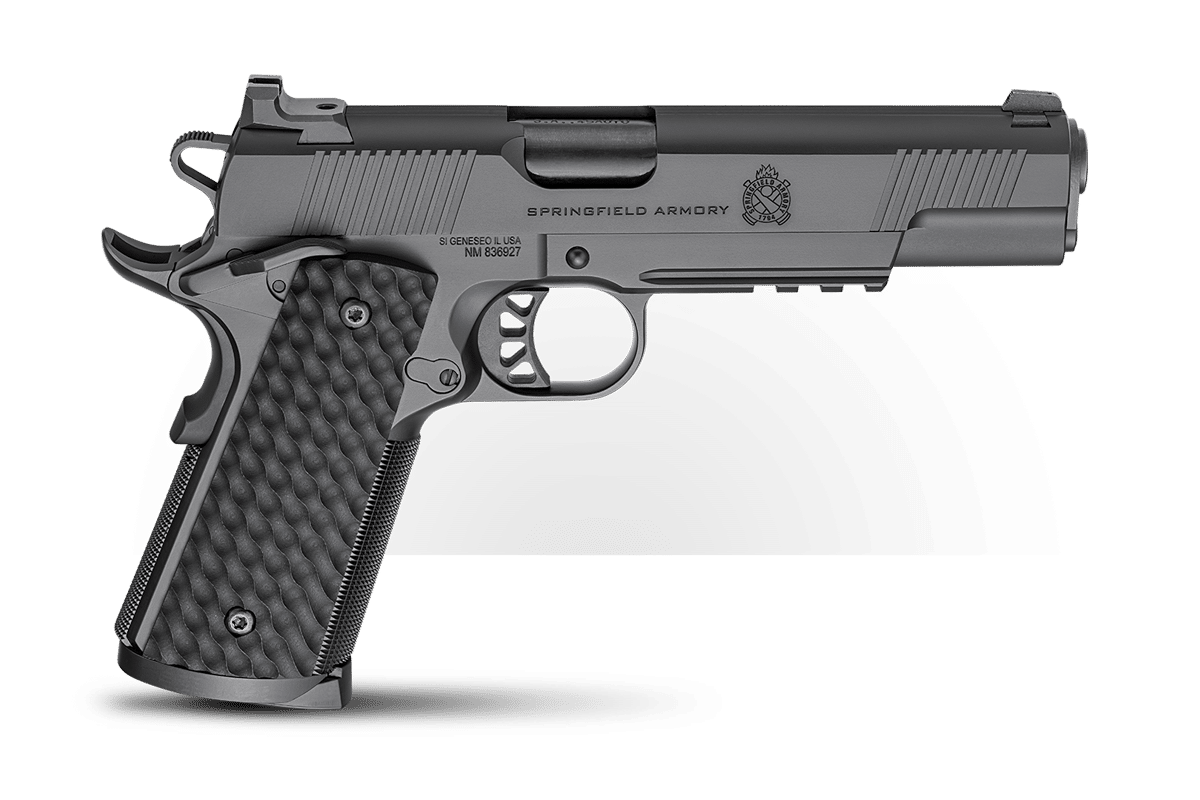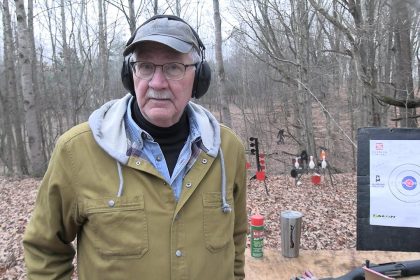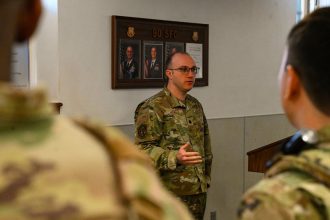Despite the 9mm Luger cartridge being currently much more popular than the .45 ACP, the debate as to which is the best self-defense round continues. It is pretty much conceded that the 9mm pistol can hold more rounds in the same-size package, and it’s undeniable that in similar-sized guns, the 9mm will have distinctly less recoil. It is likewise uncontested that 9mm practice ammo is much more affordable than that for .45 ACP.
However, there is also the matter of which can inflict more fight-stopping damage in a life-or-death situation. Two great influencers of the past, gun expert Jeff Cooper and famed wound ballistics authority Dr. Martin Fackler, postulated that with the same type of bullet a single .45 slug should create approximately 60% more wound volume than a single 9mm projectile.
It is generally conceded that the heir to Dr. Fackler’s position as the leading authority on wound ballistics today is his former protégé, Dr. Gary Roberts. On 3/30/25, he wrote “There is no doubt that, on a shot-for-shot basis, .45 Auto makes a larger hole in tissue than 9mm. However, 9mm service pistols typically hold more cartridges, often are lighter to carry, are easier to shoot, put less strain on the joints/body, are generally less expensive to train with, and can prove beneficial when trying to get ‘non-shooters’ who need to be armed with a handgun routinely qualified.” The comment appears on Page 6 of this discussion thread on the excellent forum, Pistol-Forum.com, and can be found here.
Now, we can all agree on one thing: Shot placement is the most critical element. The lighter-kicking gun, with which one should be able to afford more skill-building practice, offers both those enhancements to shot placement.
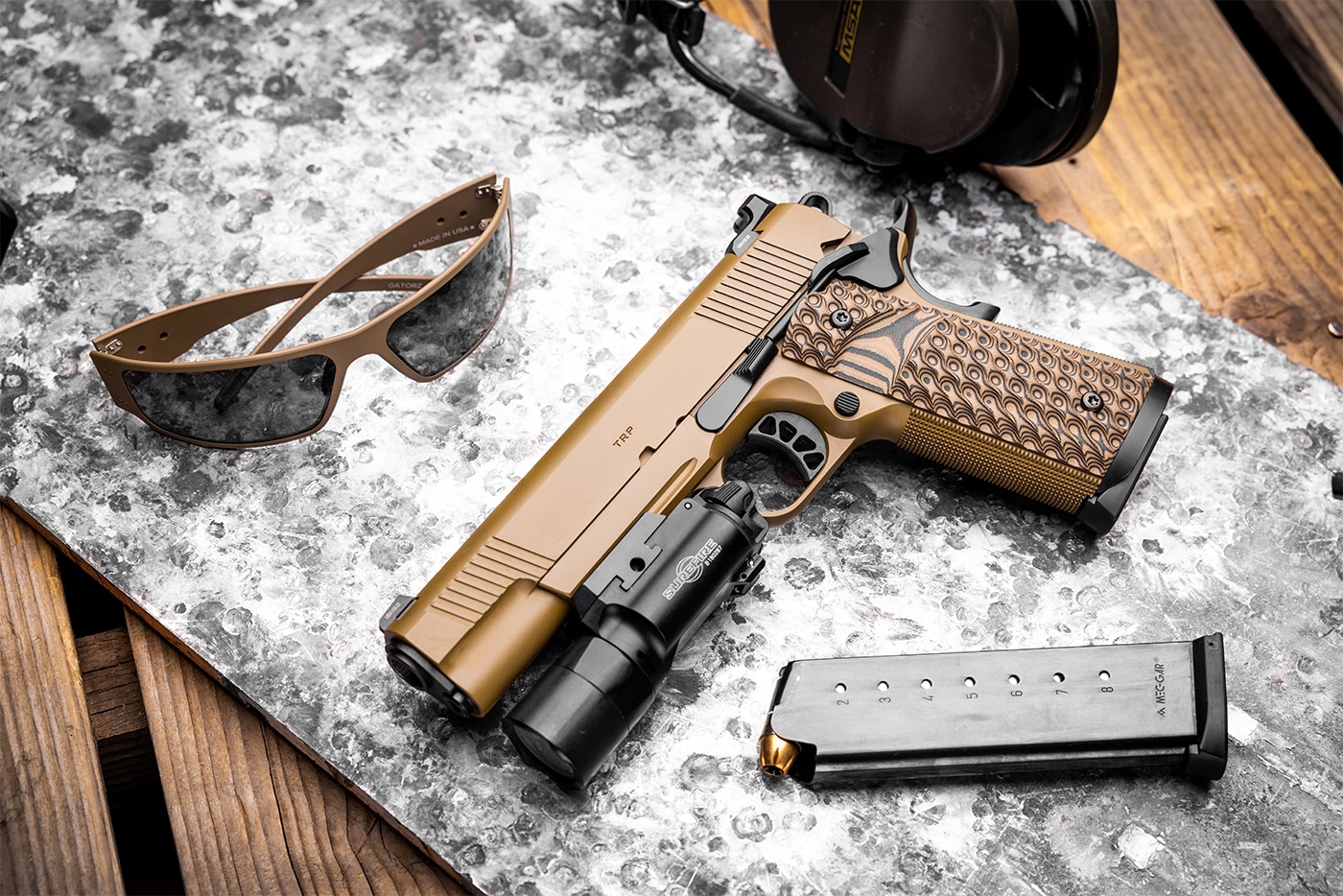
Hypothetically, even if one accepts the 60% wound volume advantage over the 9mm that was postulated for the .45, two hits with the 9mm should exceed the wound volume of the single .45 and overcome that 60% advantage. Some have speculated that with its lighter recoil, the 9mm should indeed be capable of delivering twice the speed and number of hits as the larger caliber.
For some shooters, particularly the less experienced, that might be true … but not for all. To explore the issue, we can look at fairly large-scale comparisons, but we really need to look to what the individual in question is capable of. So…
In a Bigger Picture
In the mid-1970s, Richard Davis created the sport of bowling pin shooting with his famous Second Chance Match in Central Lake, Michigan. It ran until 1998 and was revitalized as The Pin Shoot in 2017. Having shot in 30 of these events over the decades, I’ve seen some interesting research come out of it.
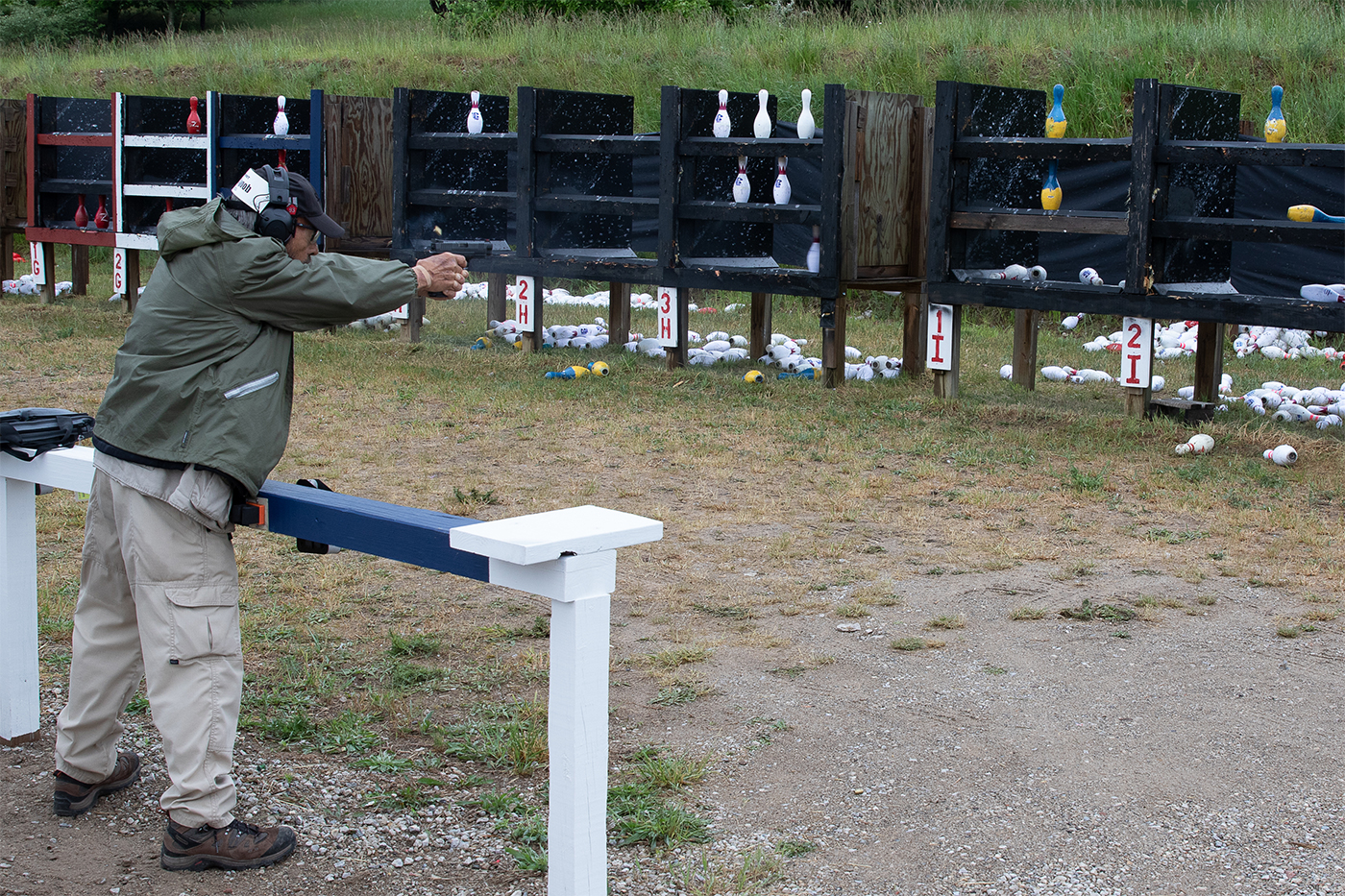
The original format was shooting five bowling pins three feet back off a table, with whoever “cleared the table” fastest being the winner. It was discovered early on that 9mm Luger bullets wouldn’t blow the heavy pins completely off the table reliably, and .45 ACP consequently became the dominant choice of the winners.
By the mid-2020s, the match sponsors had recognized that 9mm was so popular in the handgun world that many potential competitors didn’t even own larger-caliber handguns, so they added a “stock minor” category in which 9mms could compete, with the five pins set farther back on the table to make it easier to topple them completely off. This created an interesting test bed for comparing the two calibers.
Final results are an aggregate of the time it took to completely clear five, five-pin tables. In 2024, the top five shooters in the 9mm event cleared their five tables, 25 pins, in an average time of 24.53 seconds. In the regular stock gun event, with most of the top five shooters running .45s, and one a .357 Magnum revolver, the average time was 25.716 seconds. The difference overall on average was 1.186 seconds.
Less than two seconds is not a lot. When divided by the 25 pins shot off the table in each aggregate, the Stock Minor’s top five shooters in the 9mm-friendly event averaged 0.9812 of one second per pin, and those with the .45s and other “big guns” averaged 1.0068 seconds per “neutralized target.”

The difference favoring the 9mm in shooting-and-hitting speed, at a distance of 25 feet on multiple targets, was exactly 0.0256 of a second per target.
Now, in fairness to the 9mm, we have to keep three things in mind. One is that the need to shoot five different targets defensively in a short time frame is unlikely to occur in nature. Another is that in shooting multiple targets, it’s fairly easy for a skilled shooter to recover from recoil during the transitions between each of those targets.
But finally, we must remember that the above data comes from serious shooters, good enough to be confident to compete in a national-level shooting match. Not every cop or law-abiding armed citizen has yet reached that level.
One is much more likely, in a real-world need for a defensive handgun, to have a single target that must be shot multiple times. To test for that, we need one target, an electronic timer, identical handguns in the two calibers being compared … and, most importantly, the individual shooter who is testing to determine their most effective choice.
Testing for the Individual
We needed guns as close as possible to identical, in the respective calibers. I chose a pair of 5” barrel, all-steel Springfield Armory 1911-A1 pistols, each with identical adjustable iron sights and each with an approximately 4.25-lb. trigger pull. The 9mm was a stainless target model and the .45, a Parkerized Range Officer. Unloaded weights were 2 lbs. 6.7 oz. for the 9mm and 2 lbs. 6.1 oz. for the .45. (The 9mm is slightly heavier because less steel is cut out of the bore of the same-diameter barrel.)
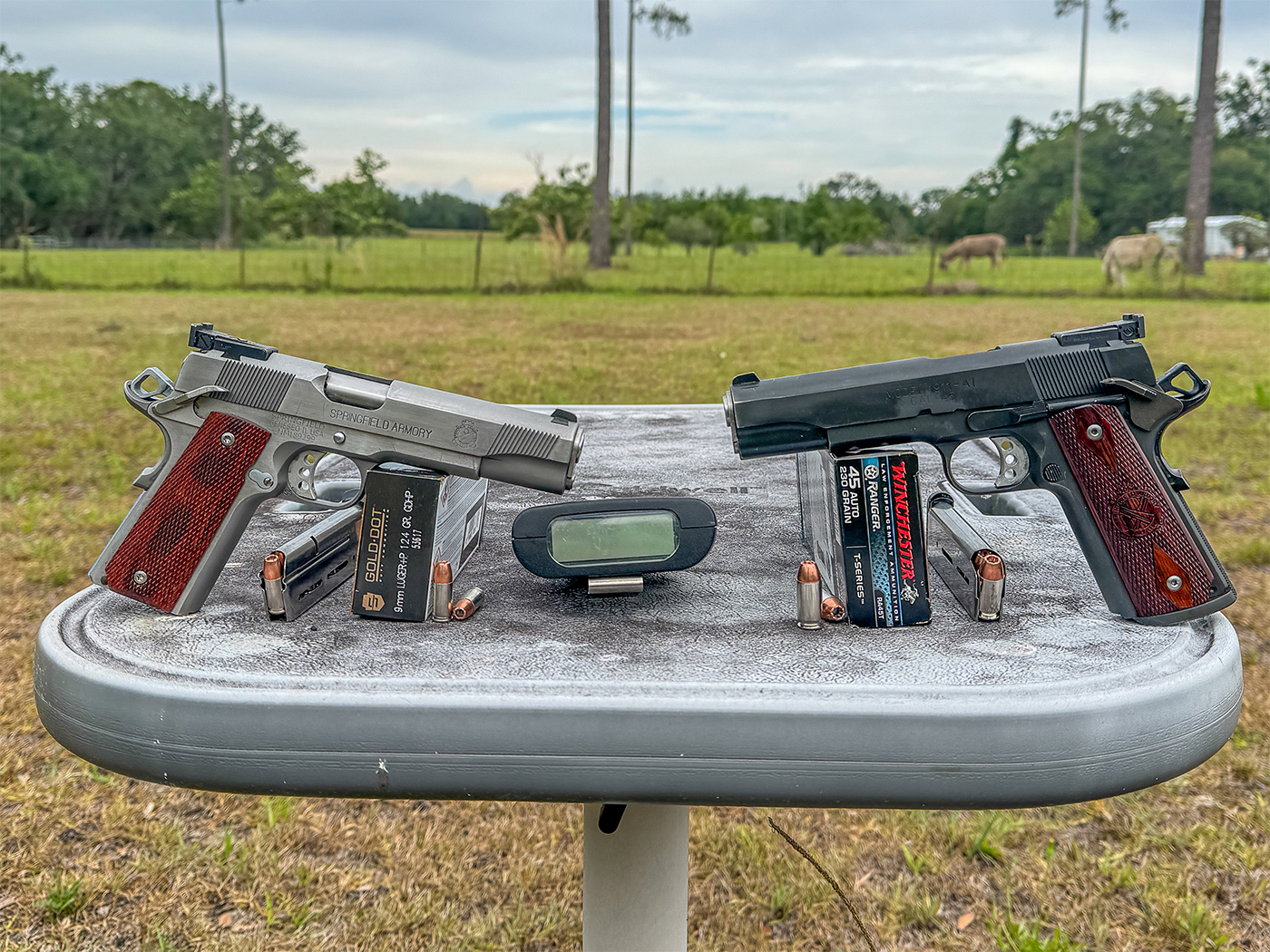
Ammo was carry loads — the 124-gr. +P Speer Gold Dot that worked so well for NYPD and Las Vegas Metro and more for the 9mm, and the street-proven Winchester 230-gr. Ranger-T for the .45. The targets were buff-colored IPSC/USPSA silhouettes. My faithful old PACT club timer rounded out the equipment set.
Distance? That’s up to the individual, based on what they think is their particular threat profile. Tom Givens has debriefed around 70 of his armed citizen graduates who’ve been in shootings and found the average distance to hover around 18 feet or six yards, so I started at six long paces from the target.
To factor out things I wasn’t measuring that day — draw speed, for example — I started with the gun on target in a strong two-hand stance, finger lightly on the trigger, awaiting the start beep. Since I wasn’t measuring my reaction time, just the shooting time, the time for the first shot was subtracted from the total to focus measurement on the time it took from shot one to the last round in each five-shot string.
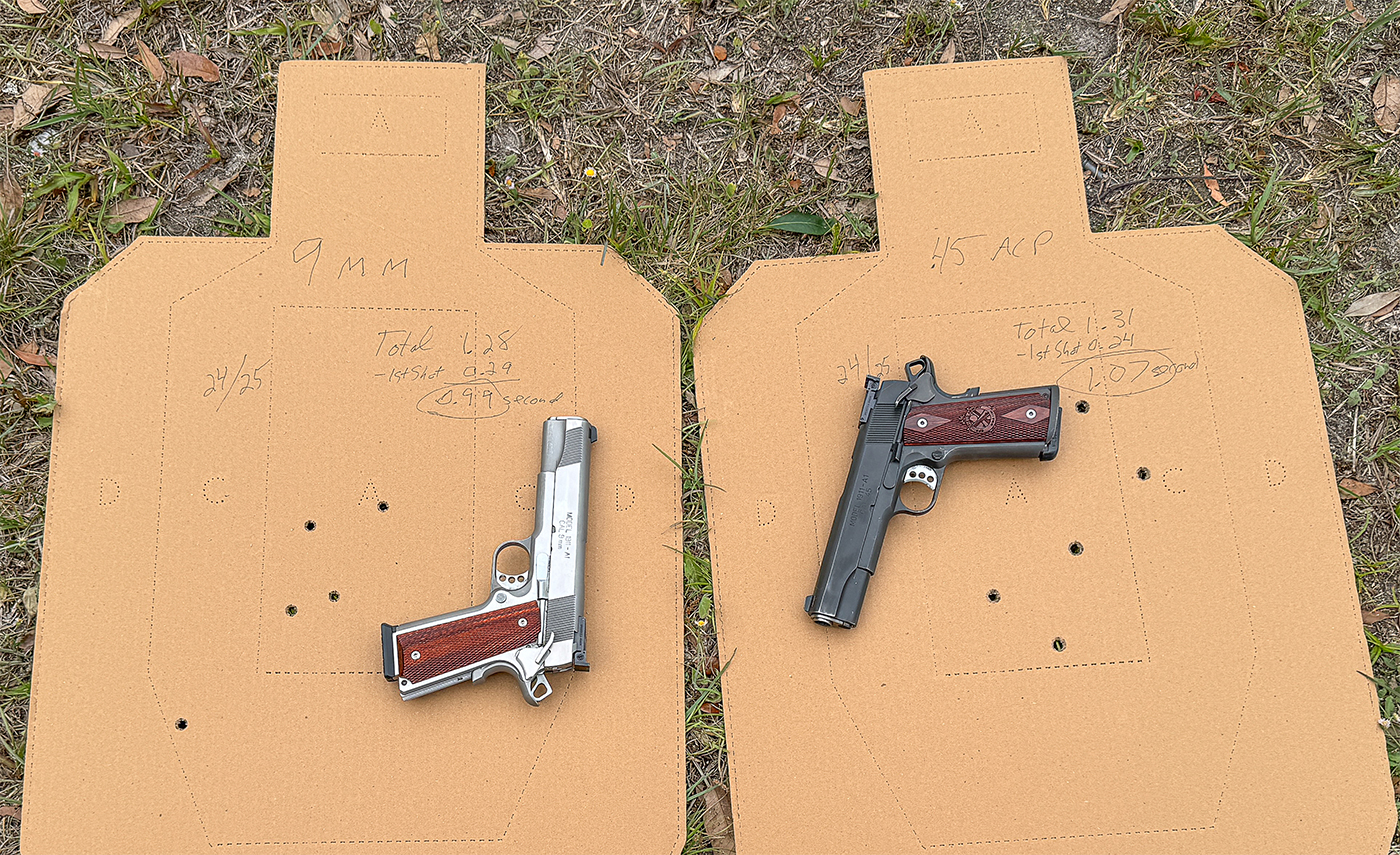
With the 9mm, total time was 1.28 seconds, including a glacial reaction time of 0.29 seconds. Timing from shot one to shot five, the quintet of bullets had been launched in just under a second: 0.99. The group measured just over 8”, with four in the center A-zone and the fifth in the one-point down C-Zone: 24 out of 25 points, or 96%.
With the .45, total time was 1.31 seconds, with a reaction time of 0.24 seconds for a total shots-fired time of 1.07 seconds. The score, with a 7.40” group, was also 96%. The difference in time was eight 100ths of one second. I, for one, consider that negligible.
Worst-Case Scenario
I don’t know who first came up with the worst-case scenario test of how the shooter does with only their non-dominant hand, but it makes sense to me. Four and a half decades ago I found myself at the Chapman Academy Advanced Pistol course with a fresh crushing comminuted fracture of the dominant hand trigger finger at the proximal joint and had to shoot the whole thing “weak hand only.” Yes, it’s relevant.
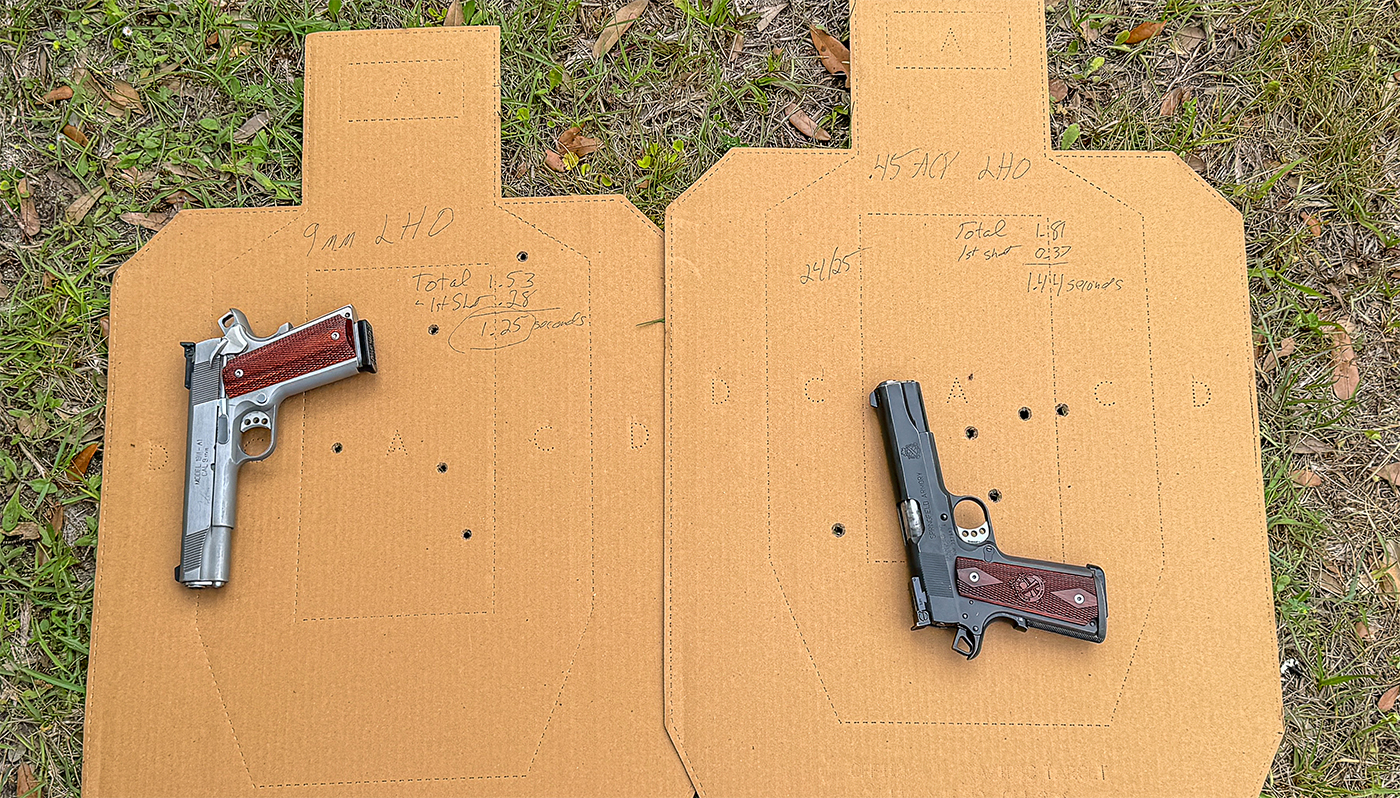
In the NRA Police Service Pistol course, the one-handed stage is done at three yards, so that was the distance I chose for this portion of the test. Shooting with my non-dominant left hand only, total time was 1.53 seconds with a reaction time of 0.28 second, for a 1.25-second total time with the 9mm. The 9.10” group was still good for a 96% score. With the .45, group size was 7.85”; score was again 96% (though one of those big bullets had barely cut the line for the A-zone and a 9mm would have barely missed); and total time was 1.81 seconds. However, that time included a “God, I’m getting old” reaction time of 0.37 seconds for a total of 1.44.
Here, there was a more distinct difference. The five hits with the .45 had taken almost a full quarter-second longer to deliver than the same string of fire with the 9mm. How much a quarter of a second is worth in that context is a question only you can answer for yourself.
Conclusions
In general, shooting faster increases human error potential: notice a point down in each of the four tests. With the two-handed shooting, I had intended to shoot as fast as I could pull the trigger but, as it was happening, I found myself switching to “as fast as I can see the front sight” mode and was definitely doing that in the one-handed shooting.
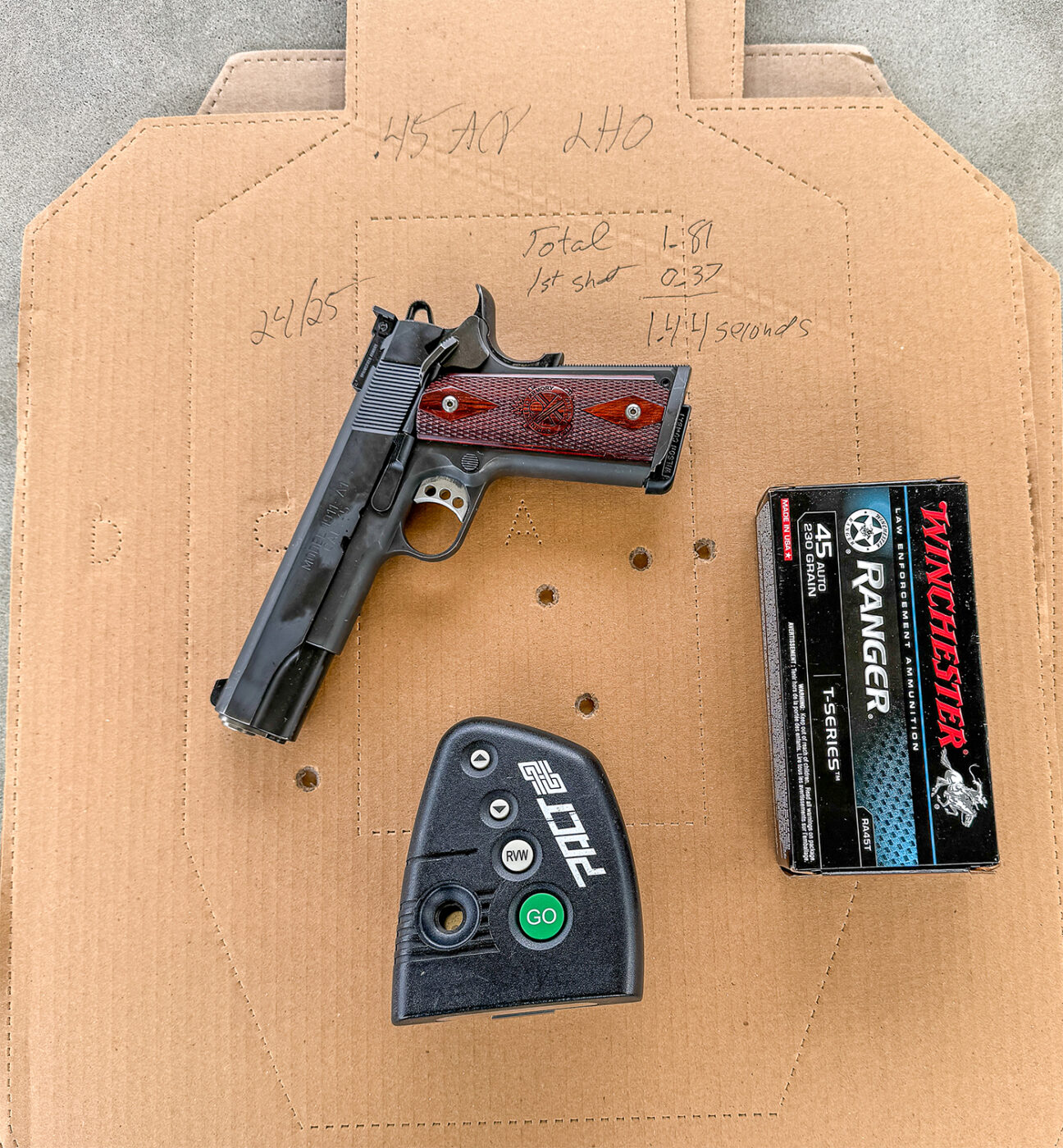
The more familiar and the more highly trained the shooter, the less recoil will slow him or her down. The tester in this example has been shooting 1911 .45s since 1960 and has had the advantage of an enormous amount of training from champions and master instructors.
The big lesson? Don’t automatically assume that you can hit with a 9mm twice as fast as you can with a more powerful pistol. The only way to find out is for you to test yourself with both. Use a timer, and score the targets, because the timer and the targets don’t lie.
Editor’s Note: Please be sure to check out The Armory Life Forum, where you can comment about our daily articles, as well as just talk guns and gear. Click the “Go To Forum Thread” link below to jump in and discuss this article and much more!
Join the Discussion
Featured in this article
Read the full article here



